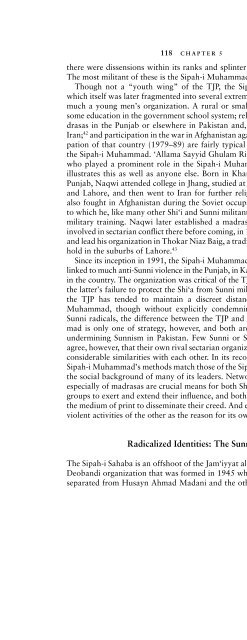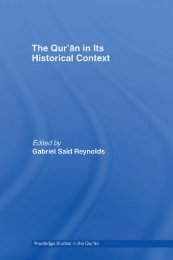Download (1 MB) - Islam and Christian-Muslim Relations: Articles ...
Download (1 MB) - Islam and Christian-Muslim Relations: Articles ...
Download (1 MB) - Islam and Christian-Muslim Relations: Articles ...
Create successful ePaper yourself
Turn your PDF publications into a flip-book with our unique Google optimized e-Paper software.
118 CHAPTER 5there were dissensions within its ranks <strong>and</strong> splinter groups developed. 39The most militant of these is the Sipah-i Muhammad Pakistan. 40Though not a “youth wing” of the TJP, the Sipah-i Muhammad—which itself was later fragmented into several extremist groups 41 —is verymuch a young men’s organization. A rural or small-town background;some education in the government school system; religious studies at madrasasin the Punjab or elsewhere in Pakistan <strong>and</strong>, not infrequently, inIran; 42 <strong>and</strong> participation in the war in Afghanistan against the Soviet occupationof that country (1979–89) are fairly typical of the leadership ofthe Sipah-i Muhammad. ‘Allama Sayyid Ghulam Riza Naqwi (b. 1960),who played a prominent role in the Sipah-i Muhammad’s early career,illustrates this as well as anyone else. Born in Khanewal district in thePunjab, Naqwi attended college in Jhang, studied at madrasas in Multan<strong>and</strong> Lahore, <strong>and</strong> then went to Iran for further religious education. Healso fought in Afghanistan during the Soviet occupation, an experienceto which he, like many other Shi‘i <strong>and</strong> Sunni militants, owed much of hismilitary training. Naqwi later established a madrasa in Jhang <strong>and</strong> wasinvolved in sectarian conflict there before coming, in 1993, to live, preach,<strong>and</strong> lead his organization in Thokar Niaz Baig, a traditionally Shi‘i strongholdin the suburbs of Lahore. 43Since its inception in 1991, the Sipah-i Muhammad has frequently beenlinked to much anti-Sunni violence in the Punjab, in Karachi, <strong>and</strong> elsewherein the country. The organization was critical of the TJP for what it saw asthe latter’s failure to protect the Shi‘a from Sunni militancy. 44 For its part,the TJP has tended to maintain a discreet distance from the Sipah-iMuhammad, though without explicitly condemning its militancy. ToSunni radicals, the difference between the TJP <strong>and</strong> the Sipah-i Muhammadis only one of strategy, however, <strong>and</strong> both are taken to st<strong>and</strong> forundermining Sunnism in Pakistan. Few Sunni or Shi‘i militants wouldagree, however, that their own rival sectarian organizations in fact exhibitconsiderable similarities with each other. In its recourse to violence, theSipah-i Muhammad’s methods match those of the Sipah-i Sahaba, as doesthe social background of many of its leaders. Networks of mosques <strong>and</strong>especially of madrasas are crucial means for both Shi‘i <strong>and</strong> Sunni radicalgroups to exert <strong>and</strong> extend their influence, <strong>and</strong> both have profusely usedthe medium of print to disseminate their creed. And each has adduced theviolent activities of the other as the reason for its own existence.Radicalized Identities: The SunnisThe Sipah-i Sahaba is an offshoot of the Jam‘iyyat al-‘Ulama’-i <strong>Islam</strong>, theDeob<strong>and</strong>i organization that was formed in 1945 when some ‘ulama hadseparated from Husayn Ahmad Madani <strong>and</strong> the other “nationalists” of



